|
Bolger's Hope |

|
|
by Ross Lillistone - Esk, Queensland - Australia |
Here are photos of the two Phil Bolger Hope designs which I built. I'll put together a written piece when I can, but for your immediate information, here are some criptic notes and photos:
| The white boat was the first. The engine is a Yanmar 1GM10, 2.21:1 reduction, 12 x 10 prop. |
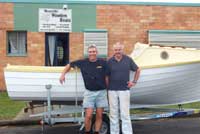
|
|
(click images for larger views) |
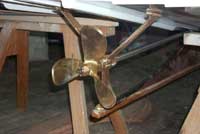 |
The bronze Y-strut for the prop shaft is my own design, which I had custom cast. It had to be a Y to support the light, cut-away skeg from side loads
|
|
| In both boats, the main bulkhead is from 18mm (3/4in to you blokes) ply with doublers fore and aft at floor level. This forms the structural heart of the cabin conversion |
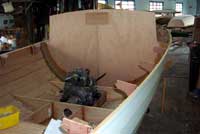
|
|
|
 The green boat carries a 15hp Yamaha 4-stroke short-shaft outboard. Again, the well and bulkheading arrangement aft is my own, done with Phil's blessing. For some reason he seems to have trusted me! Note how nice and low the engine cowling works out yusing the short-shaft. The aft bulkhead is carried up to deck level to preserve freeboard The green boat carries a 15hp Yamaha 4-stroke short-shaft outboard. Again, the well and bulkheading arrangement aft is my own, done with Phil's blessing. For some reason he seems to have trusted me! Note how nice and low the engine cowling works out yusing the short-shaft. The aft bulkhead is carried up to deck level to preserve freeboard
|
|
| The round deadlight on the white boat was specified by the owner - I would have preferred an eliptical one |

|
|
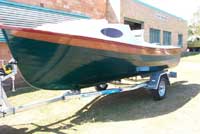 |
The eliptical deadlight on the green boat is too large to my eye, but the owner insisted
|
|
| The cockpit floor of the white boat is not self-draining |
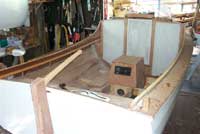
|
|
 |
The cockpit of the green boat is totally sealed (with screw-in hatches for access) and sefl-draining
|
|
| The space under the outboard splash-well on the green boat carries the fuel tank and the battery |
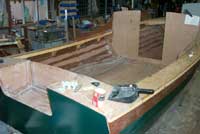
|
|
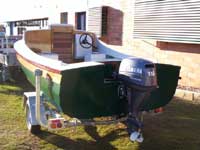 |
The underdeck volumes each side of the outboard well are totally filled with poured urethane foam
|
|
| The plastic seats on the green boat were the owner's idea, not mine! |
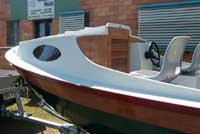
|
|
|
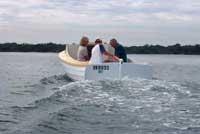
|
The photos of the white boat at speed were taken after the official launching. As you can see, she is running over displacment speed and pulling a wave. However, the trim is still very good. |
|
| Since that time, we have re-pitched the prop to 8 1/2inches to allow the motor to rev more freely. |
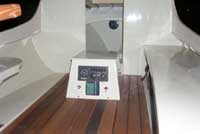
|
|
 |
At the time of the photos, it was only getting to about 3100 engine RPM, which meant that the motor was not delivering anything like it's rated horsepower
|
|
 The outboard boat is very quiet and smooth, and seems to run at between 10 and 12knots. No subsequent reports from her owner - he just picked up the boat and disappeared! He was the sort of person who would complain bitterly if anything was wrong (ex-Australian Army Warrant Officer) so I take it as a sign that the boat has been totally satisfactory The outboard boat is very quiet and smooth, and seems to run at between 10 and 12knots. No subsequent reports from her owner - he just picked up the boat and disappeared! He was the sort of person who would complain bitterly if anything was wrong (ex-Australian Army Warrant Officer) so I take it as a sign that the boat has been totally satisfactory |
|
|
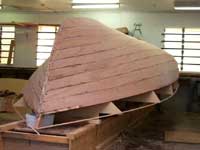
|
The lining-off of the lapstrake planking (again, done with PCB's blessing) was the most difficult lining-off job I've done to date. I think that it was so because of the combination of the wide flaring bow and the wide, flat aft sections. |
|
| It nearly brought me to tears on the day, but after about eight hours of sporadic work shifting battens, it suddenly came out the way I wanted. |
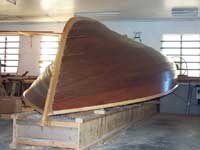
|
|
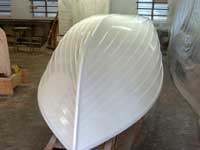 |
Phil Bolger has often commented that lining-off is a real test of a builder's skill, and I'm happy (boasting!!) to report that he was happy with my result (Chuck, don't print that I said that!!!!) (I won't. Ross {wink} - Chuck)
|
|
| The planking in both boats was 9mm (3/8") marine ply |
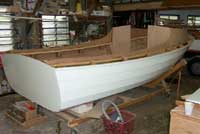
|
|
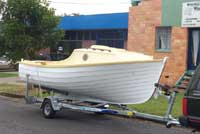 |
Cuddy and deck design in both cases was my own - I appologised to Phil, telling him that the owners insisted.
|
|
| Construction plan in both cases was my own - I just bought the hull shape from Phil |
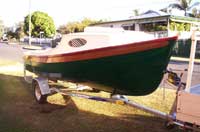
|
|
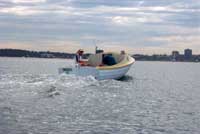 |
The boats are extremely stable, and both handle beautifully, riding very softly into a steep headsea
|
|
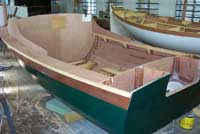 In the background of one of the photos you can plainly see another PCB boat I was building at the time. She is Phil's Harbinger catboat, and she is absolutely beautiful, in and out of the water. Construction was one layer of 7mm WRC strip, followed by two diagonal layers of 1/8" hoop pine marinne plywood in narrow planks. A big job for me - 18,000 stainless staples put in and removed individually. Lapstrake is a much more sensible method... In the background of one of the photos you can plainly see another PCB boat I was building at the time. She is Phil's Harbinger catboat, and she is absolutely beautiful, in and out of the water. Construction was one layer of 7mm WRC strip, followed by two diagonal layers of 1/8" hoop pine marinne plywood in narrow planks. A big job for me - 18,000 stainless staples put in and removed individually. Lapstrake is a much more sensible method... |
|
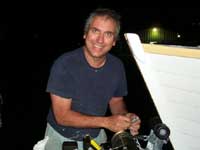 |
Best Wishes
Ross Lillistone
Bayside Boat Shop
|
|

|